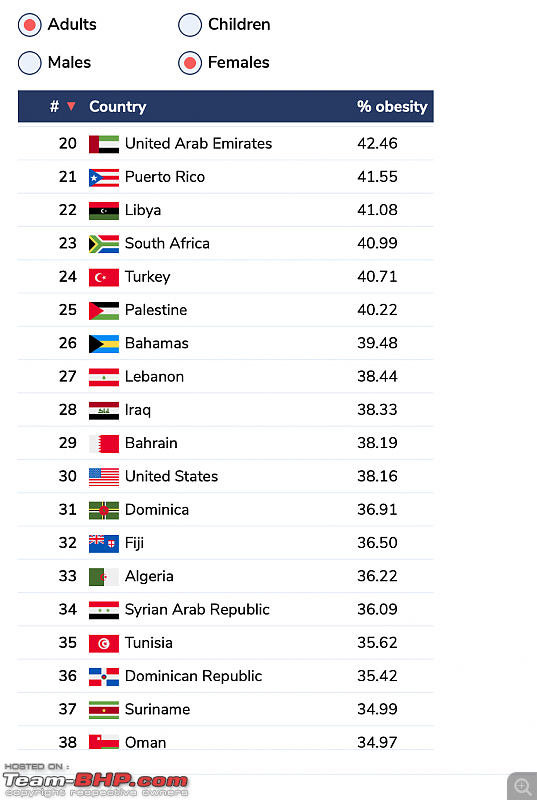
 |
| More than 4 billion people — or 45% of the world's population — could be overweight by 2050, with 1.5 billion — 16% — of them obese, if the current global dietary trend towards processed foods continues. This from a first-of-its-kind study from the Potsdam Institute for Climate Impact Research. Providing a long-term overview of changing global eating habits between 1965 and 2100, the researchers used an open-source model to forecast how food demand would respond to a variety of factors such as population growth, ageing, growing body masses, declining physical activity and increased food waste. While trends vary between regions, global eating habits were moving away from plant- and starch-based diets to more "affluent diets high in sugar, fat, and animal-source foods, featuring highly-processed food products". |

| Now, global food demand would leap 50% by mid-century, pushing past Earth's capacity to sustain nature. Food production already uses up three-quarters of the world's fresh water and one-third of its land — and accounts for up to a third of greenhouse gas emissions. Also, as a result of increasing inequality along with food waste and loss — food that is produced but not consumed due to lack of storage or overbuying — around half a billion people will still be undernourished by mid-century. |
|
Originally Posted by roy_libran
(Post 4934861)
In general, and with a certain privilege at play inherently, we survive far longer than what the natural design intends us to, bolstered by the holy grail of modern medical science. But that cumulative longer lifespan entails huge environmental costs which impact other species as also the lesser privileged sections of our species. The key to a healthy species is not about longevity but it is about the vitality of the gene pool which comes about through greater reproduction rates thus increasing genetic diversity. Every other species on our planet follows this blueprint. The human situation is only going to worsen simply because we humans aren't designed to see ahead far enough, while having tools to affect the future far enough. |
|
Originally Posted by Jeroen
(Post 4934879)
When we lived in Kansas City this was very clear. In the wealthy suburbs there were no fat people. At least not living, if you saw an overweight person it was likely somebody on his/her way to clean somebodies house. |
|
Originally Posted by Kosfactor
(Post 4934922)
The two sides of Poverty - one there is not enough to eat an another is obesity - the second category is mostly confined to United States. Its an exception indeed among many other quirks of USA. |
|
Originally Posted by Kosfactor
(Post 4934922)
The two sides of Poverty - one there is not enough to eat an another is obesity - the second category is mostly confined to United States. Its an exception indeed among many other quirks of USA. Obesity is more prevalent in wealthier countries (not necessarily per capita), because you need to be able to afford to eat more than you need. |
|
Originally Posted by am1m
(Post 4934955)
I remember reading that this is because in the US, it is actually cheaper to eat at a McDonalds or a KFC than it would be to cook at home. That, combined with the 'supersize' strategy to serving portions in those sorts of junk food places probably leads to this phenomenon. . |



| Cutler and Lleras-Muney (2006) found that those with more years of schooling are less likely to smoke, drink a lot, to be overweight or obese or to use illegal drugs. Similarly, the better educated are more likely to exercise and to obtain preventive care such as flu shots, vaccines, mammograms, pap smears and colonoscopies. They also found the relationship between education and health appears to be non-linear for obesity, with increasing effects of additional years of schooling. A review by Grossman and Kaestner concluded that years of formal schooling is the most important correlate of good health (Grossman et al., 1997). Cross-sectional estimates from a study of twins conducted by Webbink et al. (2008), also confirms the negative relationship between education and the probability of being overweight. By looking at differences between the sexes within a study of socio-economic factors and obesity, Yoon et al. (2006) found that income, rather than education, had a greater effect on BMI and waist circumference in men, whereas higher levels of education for women resulted in lower BMI and waist circumference. The correlation between education and health may reflect three possible types of relationships: a) a causal link running from increased education to improved health, b) a reverse causal link, indicating that better health leads to greater education; or c) an absence of a causal relationship between education and health, which appear to be correlated because of possible unobserved factors affecting both health (or obesity) and education in the same direction. The three pathways are not mutually exclusive, of course, and some combination of the three is likely to provide the most plausible explanation of the strong correlations consistently found across countries between education and health, or obesity. Cutler and Lleras-Muney (2006) argue that children in poor health obtain less schooling and because of this they are also more likely to be unhealthy adults. Similarly, evidence on longitudinal data shows that becoming overweight during the first four years in school is a significant risk factor for adverse school outcomes in girls (Datar and Sturm, 2006). Unobserved factors possibly contributing to the third pathway identified may include family background, genetic traits or other individual differences, such as ability to delay gratification. These factors may explain why the more educated are also healthier. Cutler and Lleras-Muney (2006) found that even controlling for some of these factors, the effect of education on health generally remains large and significant. Although there is evidence to support the hypothesis that the direction of causality is from more schooling to better health (Grossman, 2000), when overall health status or longevity are the outcomes of interest, there are few studies shedding light on the causal nature of the relationship between education and obesity specifically. Results from Lundborg (2008) suggest that a causal effect of education on health exists, but found no evidence that lifestyle factors such as smoking and obesity contribute to the health/education gradient. Natural experiments where policy changes are implemented that directly affect the number of years of mandatory schooling, can provide an indication of the causal nature of the link between education and obesity |
|
Originally Posted by Jeroen
(Post 4934969)
No sorry, obesity is not confined to the USA, |
|
Originally Posted by srini1785
(Post 4934999)
Could someone please define " Obese " in technical terms before getting into discussions on the click bait topic?. |
|
Originally Posted by Kosfactor
(Post 4934991)
How about India? We have a substantial population with obesity here. Consider 14% of 1.3 Billion. Consider 6% of 1.4 Billion in China. These are populations that have witnessed rapid economic growth and rising incomes over the last few decades. |
|
Originally Posted by V.Narayan
(Post 4935022)
One definition now often used is a BMI of over 30 being moderately obese and a BMI of over 35 being severely obese. How effective is BMI and whether it caters to all body shapes and structures I do not know but doctors tend to use it a lot these days. |
|
Originally Posted by Samurai
(Post 4935032)
Well, if you look at the link given by Jeroen, India has one of the lowest obesity, we are ranked at 187th for males and 194th for females out of 200 countries. |

|
Originally Posted by Jeroen
(Post 4934969)
Check the website in my earlier post for the top 50: USA in number 30! |
|
Originally Posted by Kosfactor
(Post 4935067)
Numbers are staggering, out of the 650 Million obese globally, we have 135 Million, something to think about. |
| All times are GMT +5.5. The time now is 13:03. |